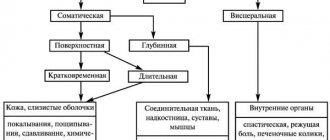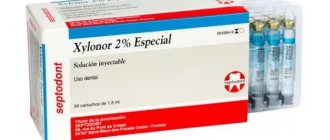Comparison of the effectiveness of Analgin and Tempalgin
Tempalgin is more effective than Analgin - this means that the ability of the drug substance to provide the maximum possible effect is different.
For example, if the therapeutic effect of Tempalgin is more pronounced, then with Analgin it is impossible to achieve this effect even in large doses.
Also, the speed of therapy is an indicator of the speed of therapeutic action; Tempalgin and Analgin are also different, as is bioavailability - the amount of a drug substance reaching the place of its action in the body. The higher the bioavailability, the less it will be lost during absorption and use by the body.
Comparison of the effectiveness of Baralgin M and Tempalgin
Tempalgin is more effective than Baralgin M - this means that the ability of the drug substance to provide the maximum possible effect is different.
For example, if the therapeutic effect of Tempalgin is more pronounced, then with Baralgin M it is impossible to achieve this effect even in large doses.
Also, the speed of therapy is an indicator of the speed of the therapeutic action; Tempalgin and Baralgin M are also different, as is bioavailability - the amount of the drug reaching the site of its action in the body. The higher the bioavailability, the less it will be lost during absorption and use by the body.
Comparison of the safety of Analgin and Tempalgin
The safety of a drug includes many factors.
At the same time, in Analgin it is quite similar to Tempalgin. It is important where the drug is metabolized: drugs are excreted from the body either unchanged or in the form of products of their biochemical transformations. Metabolism occurs spontaneously, but most often involves major organs such as the liver, kidneys, lungs, skin, brain and others. When assessing the metabolism of Analgin, as well as Tempalgin, we look at which organ is the metabolizing organ and how critical the effect on it is.
The risk-benefit ratio is when the prescription of a drug is undesirable, but justified under certain conditions and circumstances, with the obligatory observance of caution in use. At the same time, Analgin does not have any risks when used, just like Tempalgin.
Also, when calculating safety, it is taken into account whether only allergic reactions occur or possible dysfunction of the main organs. In other matters, as well as the reversibility of the consequences of using Analgin and Tempalgin.
Comparison of safety of Baralgin M and Tempalgin
The safety of a drug includes many factors.
At the same time, in Baralgin M it is quite similar to Tempalgin. It is important where the drug is metabolized: drugs are excreted from the body either unchanged or in the form of products of their biochemical transformations. Metabolism occurs spontaneously, but most often involves major organs such as the liver, kidneys, lungs, skin, brain and others. When assessing the metabolism of Baralgin M, as well as Tempalgin, we look at which organ is the metabolizing organ and how critical the effect on it is.
The risk-benefit ratio is when the prescription of a drug is undesirable, but justified under certain conditions and circumstances, with the obligatory observance of caution in use. At the same time, Baralgin M does not have any risks when used, just like Tempalgin.
Also, when calculating safety, it is taken into account whether only allergic reactions occur or possible dysfunction of the main organs. In other matters, as well as the reversibility of the consequences of using Baralgin M and Tempalgin.
Comparison of addiction between Analgin and Tempalgin
Like safety, addiction also involves many factors that must be considered when evaluating a drug.
So, the totality of the values of such parameters as “o syndrome” in Analgin is quite similar to the similar values in Tempalgin. Withdrawal syndrome is a pathological condition that occurs after the cessation of intake of addictive or dependent substances into the body. And resistance is understood as initial immunity to a drug; in this it differs from addiction, when immunity to a drug develops over a certain period of time. The presence of resistance can only be stated if an attempt has been made to increase the dose of the drug to the maximum possible. At the same time, Analgin’s syndrome values are quite small, however, the same as Tempalgin’s.
Comparison of addiction between Baralgin M and Tempalgin
Like safety, addiction also involves many factors that must be considered when evaluating a drug.
So, the totality of the values of such parameters as “syndrome o” in Baralgin M is quite similar to the similar values in Tempalgin. Withdrawal syndrome is a pathological condition that occurs after the cessation of intake of addictive or dependent substances into the body. And resistance is understood as initial immunity to a drug; in this it differs from addiction, when immunity to a drug develops over a certain period of time. The presence of resistance can only be stated if an attempt has been made to increase the dose of the drug to the maximum possible. At the same time, in Baralgin M the meaning of the “syndrome” is quite small, however, the same as in Tempalgin.
Comparison of side effects of Analgin and Tempalgin
Side effects or adverse events are any adverse medical event that occurs in a subject after administration of a drug.
Analgin has more adverse effects than Tempalgin. This implies that the frequency of their occurrence is low in Analgin, and low in Tempalgin. Frequency of manifestation is an indicator of how many cases of an undesirable effect from treatment are possible and registered. The undesirable effect on the body, the strength of influence and the toxic effect of drugs are different: how quickly the body recovers after taking it and whether it recovers at all. When using Analgin, the body's ability to recover faster is higher than that of Tempalgin.
Comparison of side effects of Baralgin M and Tempalgin
Side effects or adverse events are any adverse medical event that occurs in a subject after administration of a drug.
Baralgin M has almost the same level of adverse events as Tempalgin. They both have few side effects. This implies that the frequency of their occurrence is low, that is, the indicator of how many cases of an undesirable effect of treatment are possible and registered is low. The undesirable effect on the body, the strength of influence and the toxic effect of Baralgin M are similar to Tempalgin: how quickly the body recovers after taking it and whether it recovers at all.
Comparison of ease of use of Analgin and Tempalgin
This includes dose selection taking into account various conditions and frequency of doses. At the same time, it is important not to forget about the release form of the drug; it is also important to take it into account when making an assessment.
The ease of use of Analgin is approximately the same as Tempalgin. However, they are not convenient enough to use.
The drug ratings were compiled by experienced pharmacists who studied international research. The report is generated automatically.
Last update date: 2020-12-04 13:44:43
Comparison of ease of use of Baralgin M and Tempalgin
This includes dose selection taking into account various conditions and frequency of doses. At the same time, it is important not to forget about the release form of the drug; it is also important to take it into account when making an assessment.
The ease of use of Baralgin M is approximately the same as Tempalgin. However, they are not convenient enough to use.
The drug ratings were compiled by experienced pharmacists who studied international research. The report is generated automatically.
Last update date: 2020-12-04 13:44:51
Comparison of the effectiveness of Ibuprofen and Tempalgin
Tempalgin is more effective than Ibuprofen - this means that the ability of the drug to provide the maximum possible effect is different.
For example, if the therapeutic effect of Tempalgin is more pronounced, then it is impossible to achieve this effect with Ibuprofen, even in large doses.
Also, the speed of therapy is an indicator of the speed of the therapeutic action; Tempalgin and Ibuprofen are also different, as is bioavailability - the amount of a drug reaching the site of its action in the body. The higher the bioavailability, the less it will be lost during absorption and use by the body.
NSAIDs and triptans for migraine: separately or together?
According to international recommendations, treatment of a migraine attack in most patients should begin with the use of a non-narcotic analgesic or non-steroidal anti-inflammatory drug (NSAID). Placebo-controlled studies in migraine have been conducted for acetylsalicylic acid (ASA) [1–4], ibuprofen [5,6], diclofenac [7–9], metamizole [10], phenazone [11], tolfenamic acid [12], paracetamol [13]. It has been shown that the combination of ASA with paracetamol and caffeine is highly effective for migraine and has advantages over separately used components [14–16]. Intravenously administered ASA relieves migraine attacks better than subcutaneously administered ergotamine [17]. The combination of ASA with metoclopramide was as effective as sumatriptan [18]. Effervescent ASA (1000 mg), ibuprofen (400 mg) and sumatriptan (50 mg) were equally effective for migraine [19,20]. A placebo-controlled study showed that the potassium salt of diclofenac in sachet form (50 and 100 mg) was as effective as sumatriptan (100 mg) in relieving migraine [9]. The selective COX type 2 inhibitor valdecoxib (20–40 mg) also reduced migraine pain [21]. The European Federation of Neurological Societies (EFNS) recommends the use of NSAIDs for the treatment of migraine, the effectiveness of which has been proven in randomized, double-blind, placebo-controlled studies [22] (Table 1). For the relief of migraine, NSAIDs with rapid accumulation in plasma (Tmax) and a short half-life (T1/2) are primarily recommended, which ensures the rapid development of analgesia and the safety of the drug upon repeated use. For this purpose, drugs have been created with modified physicochemical and pharmacokinetic properties, thanks to which rapid analgesia can be achieved (Table 2). Diclofenac, ketoprofen, ketorolac and ibuprofen are most commonly used for the treatment of migraine, since their analgesic activity is higher than that of other NSAIDs [23]. For example, after intramuscular administration of the sodium salt of diclofenac (75 mg) or after ingestion of a sachet of potassium salt of diclofenac (Voltaren-Rapid 50 mg), analgesia occurs on average after 15 minutes. The anise and menthol flavors included in the sachet improve the organoleptic properties of the drug and reduce nausea. A large randomized trial showed that in the treatment of many migraine attacks, the effectiveness of diclofenac potassium salt against headache was comparable to sumatriptan, and associated nausea and vomiting decreased significantly more often than with triptan [9] (Table 3). The clinical effectiveness of triptans for migraine has been demonstrated in large placebo-controlled studies, which are reflected in several published comparative analyses. Triptans are effective during any period of a migraine attack, but their early use increases the effectiveness of treatment [3,15,18]. The use of triptans in the aura phase before the onset of headache is ineffective. The accumulated experience of long-term use of triptans indicates that they should not be used more than 9 days a month, as this significantly increases the risk of transition from episodic migraine to chronic and contributes to the development of abusive headaches. Differences in the clinical effectiveness of triptans are determined not only by the pharmacological parameters of the drugs, but also by the individual sensitivity of the patient. In this regard, if there is no effect from using one triptan, you should not refuse to use another next time. An analysis of 53 studies shows that the effectiveness of triptans taken orally is approximately the same, and only eletriptan at a dose of 80 mg is more effective both overall and in the first 30 minutes. after taking the drug. A comparative analysis of the use of various dosage forms of triptans shows that intranasal and rectal use of these drugs is especially promising for concomitant vomiting. The European Federation of Neurological Societies (EFNS) recommends the use of triptans for the treatment of migraine, the effectiveness of which has been repeatedly proven in randomized, double-blind, placebo-controlled studies [22] (Table 4). Recently, the possibility and feasibility of the combined use of NSAIDs and triptans for the treatment of migraine has been actively discussed and studied. The results of a 2005 study showed that a fixed combination of sumatriptan (50 mg) and naproxen sodium (500 mg) was more effective in relieving migraine attacks than monotherapy with these drugs [24]. Headache relief at 2 hours was significantly greater in patients receiving the fixed combination of sumatriptan and naproxen (65%) than in patients receiving sumatriptan (49%) or naproxen (46%) monotherapy (p<0.01). Complete headache relief in this study was reported in 29% of those taking the fixed combination of sumartriptan and naproxen, 25% of those taking sumatriptan and 17% of those taking naproxen (p<0.001). The comparative effectiveness of rizatriptan (10 mg) and its combination with rofecoxib (25 mg) was studied in 56 patients with migraine. This open-label study showed no statistically significant difference between treatment groups in pain relief and associated symptoms of nausea, vomiting, photophobia, and sound sensitivity. However, the number of patients with headache relapses after its successful relief was significantly (p<0.001) lower in the group of patients taking a combination of rofecoxib and rizatriptan (20%) than in the group taking rizatriptan alone (53%). The authors found no differences between groups in the incidence of side effects [25]. Another study examined the comparative effectiveness of rizatriptan (10 mg) and its combination with rofecoxib (50 mg) and tolfenamic acid (200 mg) in the treatment of six consecutive migraine attacks in 45 patients. Complete pain relief after 2 hours was recorded in 37.9% of patients receiving rizatriptan monotherapy, 40.6% receiving combination treatment with rizatriptan and tolfenamic acid, and 62.9% receiving combination treatment with rizatriptan and rofecoxib. However, 4 hours after the treatment, there were no differences between the groups. The incidence of recurrence of migraine after successful relief was lower with the combined use of a triptan with NSAIDs (15.4% for the combination with rofecoxib and 7.7% for the combination with tolfenamic acid) than with rizatriptan monotherapy (50%) [26]. In 2007, a study was completed that confirmed the high effectiveness of the combination of sumatriptan (85 mg) and naproxen (500 mg) in the treatment of migraine attacks [27]. The authors of these and other studies suggest that the benefit of combining a triptan and an NSAID is due to the complex effects of these drugs on various mechanisms of migraine pathogenesis, as well as differences in the pharmacokinetics of these classes of drugs. The advisability of using NSAIDs during the aura phase, when triptans are not recommended, or early joint use in patients with severe migraine is emphasized. Thanks to the combined use of NSAIDs and triptans, it is possible to speed up the time of onset of analgesia, as well as prevent relapse of migraine (Fig. 1). The accumulated data allows us to formulate a number of provisions that will help increase the effectiveness of treatment of a migraine attack: 1. NSAIDs are effective for migraine and can be recommended for most patients as first-choice drugs. Administration of NSAIDs intramuscularly or in the form of a modified sachet provides a more rapid development of analgesia. If the patient cannot distinguish a migraine attack from a tension headache, then he should take an NSAID. 2. Triptans are highly effective treatments for migraine. They act on the main links in the pathogenesis of migraine and are not analgesics. They should not be taken during a migraine aura. Triptans are the first choice in patients who do not respond to NSAID therapy. There is individual sensitivity of patients to one or another triptan. 3. The combined use of NSAIDs and triptans can more effectively relieve headaches and prevent migraine relapse. 4. If nausea and vomiting are severe, NSAIDs and triptans should be avoided by mouth. Intranasal, rectal or intramuscular routes of administration are preferred.
References 1. Chabriat H, Joire JE, Danchot J, Grippon P, Bousser MG. Combined oral lysine acetylsalicylate and metoclopramide in the acute treatment of migraine: a multicentre double–blind placebo–controlled study. Cephalalgia 1994; 14: 297–300. 2. Nebe J, Heier M, Diener HC. Low-dose ibuprofen in self-medication of mild to moderate headache: a comparison with acetylsalicylic acid and placebo. Cephalalgia 1995; 15:531–535. 3. Tfelt–Hansen P., Henry P., Mulder LJ, Scheldewaert RG, Schoenen J., Chazot G. The effectiveness of combined oral lysine acetilsalicylate and metoclopramide compared with oral sumatriptan for migraine // Lancet. – 1995. – Vol. 346. – P.923–926. 4. Diener HC, Bussone G, de Liano H, et al. Placebo controlled comparison of effervescent acetylsalicylic acid, sumatriptan and ibuprofen in the treatment of migraine attacks. Cephalalgia 2004; 24:947–954. 5. Havanka–Kanniainen H. Treatment of acute migraine attack: ibuprofen and placebo compared. Headache 1989; 29:507–509. 6. Kloster R, Nestvold K, Vilming ST. A double–blind study of ibuprofen versus placebo in the treatment of acute migraine attacks. Cephalalgia 1992; 12: 169–171 7. Karachalios GN, Fotiadou A, Chrisikos N, Karabetsos A, Kehagioglou K. Treatment of acute migraine attack with diclofenac sodium: a double-blind study. Headache 1992; 32:98–100. 8. Dahlof C., Bjorkman R. Diclofenac–K (50 and 100 mg) and placebo in the acute treatment of migraine. Cephalalgia 1993; 13: 117–123. 9. The Diclofenac–K/Sumatriptan Migraine Study Group. Acute treatment of migraine attacks: efficacy and safety of a nonsteroidal antiinflammatory drug, diclofenacpotassium, in comparison to oral sumatriptan and placebo. Cephalalgia 1999; 19: 232– 240 10. Tulunay FC, Ergun H, Gulmez SE, et al. The efficacy and safety of dipyrone (Novalgin) tablets in the treatment of acute migraine attacks: a double–blind, crossover, randomized, placebo–controlled, multi–center study. Function Neurol 2004; 19: 197–202 11. Goebel H, Heinze A, Niederberger U, Witt T, Zumbroich V. Efficacy of phenazone in the treatment of acute migraine attacks: a double-blind, placebo-controlled, randomized study. Cephalalgia 2004; 24: 888–893 12. Myllyla VV, Havanka H, Herrala L, et al. Tolfenamic acid rapid release versus sumatriptan in the acute treatment of migraine: comparable effect in a double–blind, randomized, controlled, parallel–group study. Headache 1998; 38:201–207. 13. Lipton RB, Baggish JS, Stewart WF, Codispoti JR, Fu M. Efficacy and safety of acetaminophen in the treatment of migraine: results of a randomized, double-blind, placebo-controlled, population-based study. Arch Intern Med 2000; 160:3486–3492. 14. Lipton RB, Stewart WF, Ryan RE, Saper J, Silberstein S, Sheftell F. Efficacy and safety of acetaminophen, aspirin, and caffeine in alleviating migraine headache pain—three double-blind, randomized, placebo-controlled trials. Arch Neurol 1998; 55: 210–217 15. Diener HC, Pfaffenrath V, Pageler L. The fixed combination of acetylsalicylic acid, paracetamol and caffeine is more effective than single substances and dual combination for the treatment of headache: a multi–centre, randomized, double– blind, single-dose, placebo-controlled parallel group study. Cephalalgia 2005; 25: 776–787. 16. Goldstein J, Silberstein SD, Saper JR, Ryan RE Jr, Lipton RB. Acetaminophen, aspirin, and caffeine in combination versus ibuprofen for acute migraine: results from a multicenter, double–blind, randomized, parallelgroup, single–dose, placebo–controlled study. Headache 2006; 46: 444–453 17. Limmroth V, May A, Diener HC. Lysine–acetylsalicylic acid in acute migraine attacks. Eur Neurol 1999; 41:88–93. 18. Tfelt–Hansen P., Henry P., Mulder LJ, Scheldewaert RG, Schoenen J., Chazot G. The effectiveness of combined oral lysine acetilsalicylate and metoclopramide compared with oral sumatriptan for migraine // Lancet. – 1995. – Vol. 346. – P.923–926. 19. Diener HC, Eikermann A, Gessner U, et al. Efficacy of 1000 mg effervescent acetylsalicylic acid and sumatriptan in treating associated migraine symptoms. Eur Neurol 2004; 52:50–56 20. Lampl C, Voelker M, Diener HC. Efficacy and safety of 1000 mg effervescent aspirin: individual patient data meta–analysis of three trials in migraine headache and migraine accompanying symptoms. J Neurol 2007; 254:705–712. 21. Kudrow D, Thomas HM, Ruoff G, et al. Valdecoxib for treatment of a single, acute, moderate to severe migraine headache. Headache 2005; 45: 1151–1162 22. Evers, S., Afra, J., Frese, A., Goadsby PJ, Linde M., May A. and Sandor PS EFNS guideline on the drug treatment of migraine – revised report of an EFNS task force. European Journal of Neurology 2009, 16, 968–981 23. Ignatov Yu.D., Kukes V.G., Mazurov V.I. Clinical pharmacology of nonsteroidal anti-inflammatory drugs, M., GEOTAR, 2010,–258 C 24. Smith TR, Sunshine A, Stark SR, et al. Sumatriptan and naproxen sodium for the acute treatment of migraine. Headache 2005; 45:983–991. 25. Krymchantowski AV, Barbosa JS. Rizatriptan combined with rofecoxib vs. rizatriptan for the acute treatment of migraine: an open label pilot study. Cephalalgia 2002;22:309–12. 26. Krymchantowski AV, Bigal ME. Rizatriptan versus rizatriptan plus rofecoxib versus rizatriptan plus tolfenamic acid in the acute treatment of migraine. BMC Neurol 2004;4:10 27. Brandes JL, Kudrow D, Stark SR, et al. Sumatriptan–naproxen for acute treatment of migraine: a randomized trial. JAMA 2007; 297:1443–1454
Comparison of side effects of Ibuprofen and Tempalgin
Side effects or adverse events are any adverse medical event that occurs in a subject after administration of a drug.
Ibuprofen has almost the same side effects as Tempalgin. They both have few side effects. This implies that the frequency of their occurrence is low, that is, the indicator of how many cases of an undesirable effect of treatment are possible and registered is low. The undesirable effect on the body, the strength of influence and the toxic effect of Ibuprofen are similar to Tempalgin: how quickly the body recovers after taking it and whether it recovers at all.
Comparison of ease of use of Ibuprofen and Tempalgin
This includes dose selection taking into account various conditions and frequency of doses. At the same time, it is important not to forget about the release form of the drug; it is also important to take it into account when making an assessment.
The ease of use of Ibuprofen is approximately the same as Tempalgin. However, they are not convenient enough to use.
The drug ratings were compiled by experienced pharmacists who studied international research. The report is generated automatically.
Last update date: 2020-12-04 13:44:51
Comparison of addiction between Ibuprofen and Tempalgin
Like safety, addiction also involves many factors that must be considered when evaluating a drug.
So, the totality of the values of such parameters as “o syndrome” in Ibuprofen is quite similar to the similar values in Tempalgin. Withdrawal syndrome is a pathological condition that occurs after the cessation of intake of addictive or dependent substances into the body. And resistance is understood as initial immunity to a drug; in this it differs from addiction, when immunity to a drug develops over a certain period of time. The presence of resistance can only be stated if an attempt has been made to increase the dose of the drug to the maximum possible. At the same time, Ibuprofen has a fairly low incidence of “syndrome”, just like Tempalgin.
Comparison of the safety of Ibuprofen and Tempalgin
The safety of a drug includes many factors.
At the same time, it is higher for Ibuprofen than for Tempalgin. It is important where the drug is metabolized: drugs are excreted from the body either unchanged or in the form of products of their biochemical transformations. Metabolism occurs spontaneously, but most often involves major organs such as the liver, kidneys, lungs, skin, brain and others. When assessing the metabolism of Ibuprofen, as well as Tempalgin, we look at which organ is the metabolizing organ and how critical the effect on it is.
The risk-benefit ratio is when the prescription of a drug is undesirable, but justified under certain conditions and circumstances, with the obligatory observance of caution in use. At the same time, Ibuprofen has fewer risks when used than Tempalgin.
Also, when calculating safety, it is taken into account whether only allergic reactions occur or possible dysfunction of the main organs. In other matters, as well as the reversibility of the consequences of using Ibuprofen and Tempalgin.









